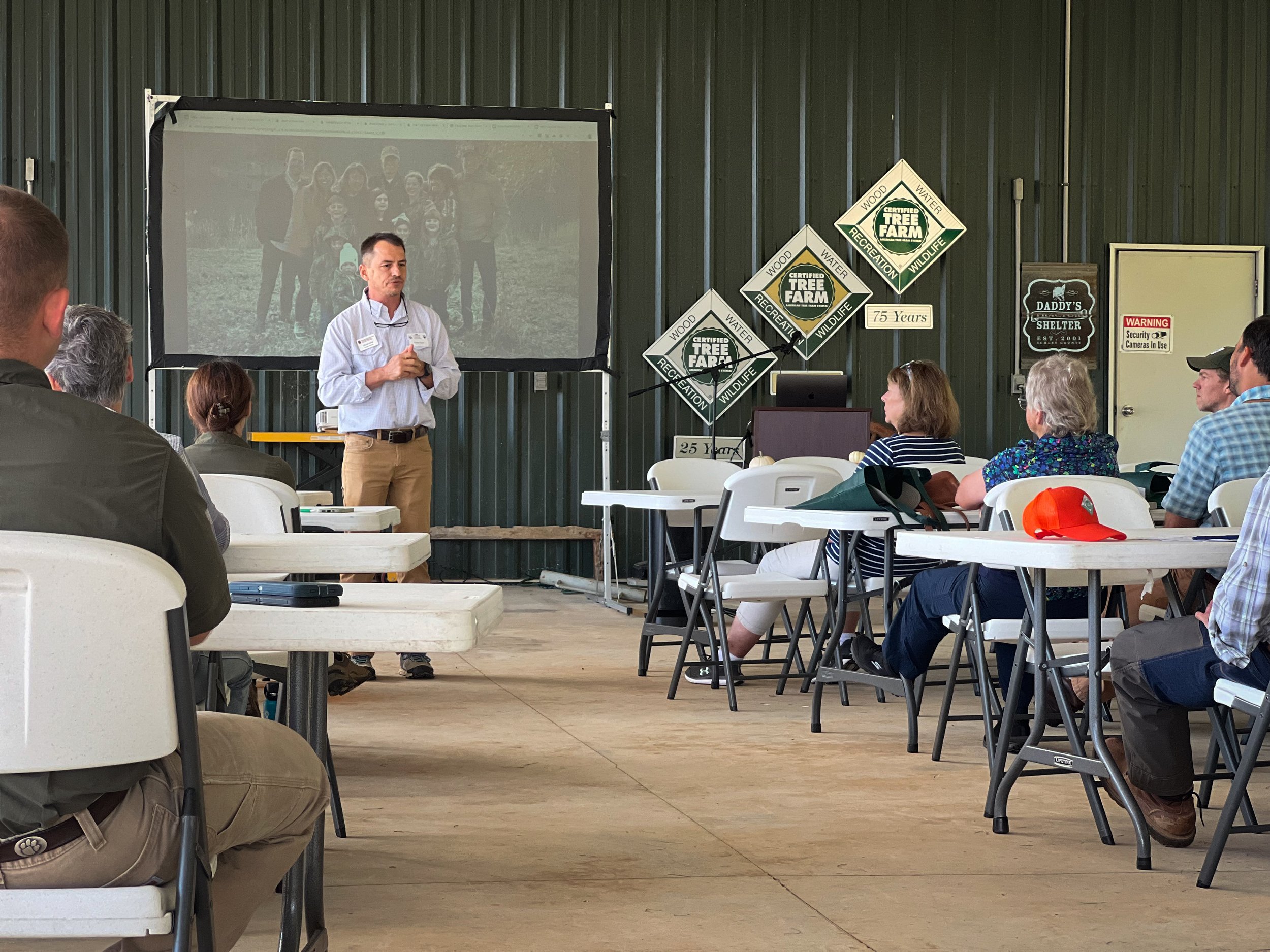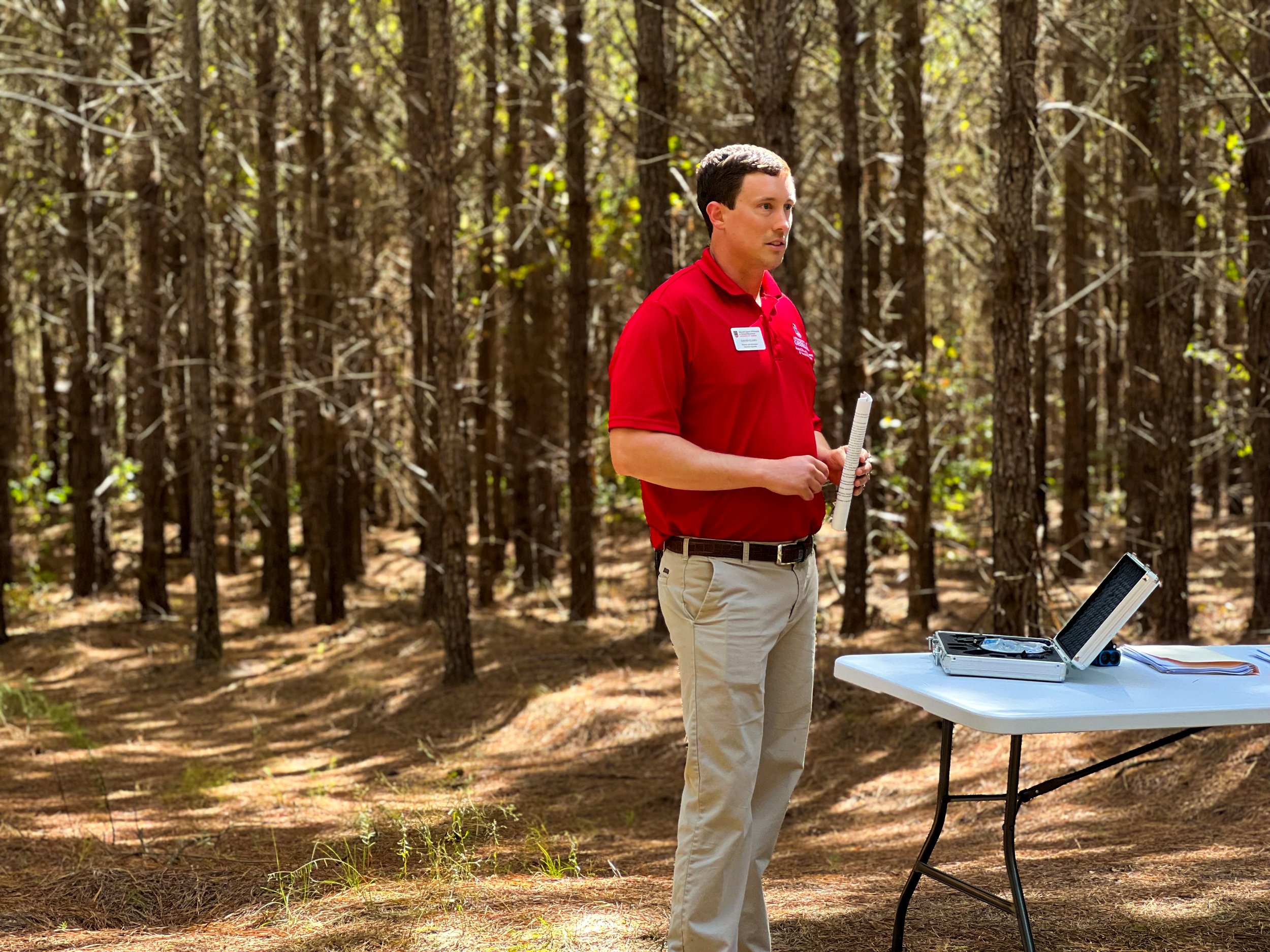As we looked at the weather forecast for the week of January 19, 2025, a snowstorm was predicted for Albany and Ellaville. It was forecast to begin Tuesday afternoon. I decided to travel to the cabin Tuesday morning to do a few shop/mechanical projects I had planned over the last few weeks.
The snow started, as predicted Tuesday afternoon, as I was relaxing with a nap in front of the fire at the cabin. I quickly decided to document the snowstorm in photos for this journal article.
While waiting for the snow to start, I decided to build a fire in the bedroom. I kept the fire going all night, as I placed the last wood on the fire after midnight Tuesday.
This is a view from the dam looking toward the boathouse late Tuesday afternoon. You can clearly see the snow falling gently.
Hopewell Methodist Church late Tuesday afternoon. I was on a mission assigned by Jean to photograph the LaCrosse store. After driving to Ellaville and seeing the condition of the roads, I decided Jean’s photo request would be honored tomorrow morning.
The main gate on Hopewell Church Road at 6:00 p.m. Tuesday.
The view out the kitchen window at 7:27 a.m. Wednesday morning. This view showed me the photography mission would be successful.
The view toward the shelter Wednesday morning. I parked the green truck under the shelter to keep the windshield clear for my trip home by way of LaCrosse later today.
Looking toward the pond with the hand pump and pumphouse in view.
This may be my favorite shot of the cabin from a distance showing the pristine snow blanket surrounding the house. This is the photo shown in the heading of the article.
Closeup of the cabin.
Wider view of cabin.
View looking parallel to the cabin with rail fence on left of photo.
A beautiful sideview of the cabin showing the kitchen. Below you will see the same view after the sun rises.
As promised above, a side view of the cabin with the sun lighting the landscape. Notice the contrast between the cloudless, dark blue sky and the white snow blanket.
How deep was the snow? My tape shows 5-1/2” on the roof of the breezeway leading to the cabin.
A good view of the snow on roof of back porch.
One more cabin side view showing the McLendon farm bell in the sunlight.
As I was about to start my trip to the Bluff House, LaCrosse, and Albany I decided to check the temperature as shown on the weather channel.
At 7:48, the Weather Channel showed the temperature in Ellaville is 11 degrees! The cabin thermometer indicated 16. Either way, it was a very cold morning with no noticeable wind. Time to start my journey home.
The next three photos need no captions as I drove by the Bluff House shelter, Bluff House, and the treehouse before heading to the front gate.
This place could use eight or so excited grandchildren—running back and forth on the walkway to the deck, ringing the bell, up and down the stairs to play in the snow, having snowball fights, making a snowman, maybe even ziplining and falling into the snow, … Oh well, maybe next time!
This is the view toward our gate as I was heading to LaCrosse and then home.
View from the road prior to opening the gate.
The following photos are from the McLendon farm at LaCrosse. Jean’s request was for a photo of the LaCrosse store, but I saw several other scenes worth preserving in photos.
This is one of my favorites! Notice the sun highlighting the subject of Jean’s request at 10:11 a.m.! This photo alone was worth the stop!
A closeup of the store. Notice it is unspoiled by footprints.
A great photo of Jean’s childhood home. Any ideas on what we should do to preserve this historical dwelling?
A good angled view of the store with the eerie shadows from one of the large oaks.
No photo tour of the McLendon farm would be complete without the barns. This was one of my favorite and most ambitious projects. The history of the barn restoration project can be found here: https://www.harrisonwoodlands.com/journal/2021/6/24/rehabilitation-of-mclendon-farm-barns
It’s hard to believe it’s been 13 years since this project! I took this photo from the long-abandoned railroad tracks.
A great photo of the main farm entrance gates on LaCrosse Road. Again, look at the pristine snow cover with not tire, animal, or human tracks.
A view of the signs adjacent to the gate, with the sign Joni made when I erected the gates 15 or so years ago. The Tree Farmer of the Year—2021 sign is prominent atop Joni’s sign.
Joni, your sign only gets better with age, and it captures the history of the farm in a very understated way—the way Mr. Jesse, that master of understatement, would want it said.
My last photo and a good one to close my photo tour. As I was driving back to Highway 271, I was struck by the beauty of this view to the northeast with the sun brilliantly illuminating the snow on the roofs of the white house, the outbuildings, and the barns.
This ends my photo tour of the Snow Storm of 2025, but Jean is not one to be outdone! Following are a few of her photos taken of our yard in Albany. She is a master of photography, as you can readily see below!
This is a night photo (9:36 p.m.) taken from our front door. Don’t you love the lighting that accentuates the brilliantly white snow?
Another of Jean’s night time photos with the “streaks” of falling snowflakes!
Last photo for the article! Early morning photo (7:28 a.m.) taken from our sunroom deck facing the pool. A perfect view of unspoiled snow. You can almost feel the silence of the morning.
Post Script: This was the largest snowstorm to hit our area since Friday, February 9, 1973. (I googled it and found the exact date. This article may be of interest: https://www.weather.gov/ilm/feb1973snow.) I was a second quarter freshman at GA Tech and had planned to come for the weekend. I remember Mama calling me and saying it was snowing and that I might consider cancelling. When she called the snow was just covering the ground.
I decided to try it and left GA Tech around 2:00 with no snow in sight. As usual, I took US Highway 19 home. When I approached Thomaston, the snow had started and the further south I traveled, the worse it got. With no other good options, I decided to continue driving, in greatly reduced visibility, in the worst snowstorm I had ever seen. I was doing well, in spite of the snow intensity increasing. A few miles north of Butler, the highway was blocked by a jackknifed tractor-trailer and I had to stop and pulled off the road.
Not long afterward, the Taylor County Sheriff’s Department showed up with a large van and took a load of stranded travelers to Butler where we were housed in the large courtroom of the county courthouse. We slept as best we could on the benches. The hospitality of Sheriff Charlie Wright was great as he kept the room very warm and somehow managed to find some food for us.
Phone service was out, so I couldn’t contact my parents to tell them I was safe. I assume they were expecting the worst. The next day, I asked the police chief to contact Marcene Ellis, the Schley County sheriff, and ask him to tell my parents I was ok.
Daddy and Jimmy (I think) drove up to get me and take me home. I don’t remember what I did about my car, but I remember someone coming into the courthouse hours after we arrived and saying he had hit a couple of stranded cars before he had to stop. One of them was mine and it had a severe scratch down the driver’s side.
The total snowfall in Schley County was over 12 inches! Somehow I made it back to GA Tech in time for classes Monday. This week’s snowfall is the second only to the 1973 snowstorm and it has been almost 52 years! Will it be another 50+ years before we have another major storm that rivals the one we had this week?

































































































































































































































































